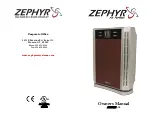
161
MAINTENANCE
INSTALLATION
6.1.2
Maintenance level 2
This level requires a specific know-how in the electrical, hy-
dronic, and mechanical fields.
This maintenance level can be performed monthly or yearly ac-
cording to the type of verification.
Under these conditions, it is recommended to perform the fol-
lowing maintenance interventions.
Perform all the level 1 operations, and then perform the fol-
lowing:
Electrical checks
− Tighten the power circuit's electrical connections at
least once a year (see the table containing the tighten-
ing torques).
− If necessary, check and tighten all the connections for
the controls/commands (the table containing the tight-
ening torques).
− Dust and clean the inside of the
− control units, if necessary.
− Check the status of the contactors, switches, and ca-
pacitors.
− Verify the presence and check the conditions of the
electrical protection devices.
− Check that all the electric heaters are functioning prop-
erly.
− Check that no water has penetrated into the control
unit.
Mechanical checks
− Check the tightness of the fastening bolts of the fan col-
umn, the fan, compressor, and the control unit.
Water circuit checks
− Always use caution when working on the water circuit,
and take care to avoid damaging the adjacent capacitor.
− Check the water connections.
− Check whether the expansion tank shows any signs of
excessive corrosion or gas leaks, and replace it if nec-
essary.
− Drain the impurities from the water circuit.
− Clean the impurities from the water filter.
− Check the fixed speed pump's bearing after 17,500 hours
of operation with water, and the seal of the mechanical
pump after 15,000 hours. Check the operation of the low
water flow safety device.
− Check the status of the pipes' thermal insulation.
− Check the concentration of the anti-freeze solution
(ethylene glycol or propylene glycol).
Cooling circuit
− Thoroughly clean the air heat exchangers with a low
pressure jet and a biodegradable detergent.
− Check the unit's operating parameters and compare
them with the previous values.
− Perform an oil contamination test. Change the oil if nec-
essary.
− Check the operation of the high pressure switch. Replace
it if faulty.
− Check the cleanliness of the dehydration filter. Replace
it if necessary.
− Keep and maintain a maintenance sheet for each unit.
9
All these operations require the user to strictly follow the
safety measures: personal protective equipment, com-
pliance with all sector regulations, compliance with all
applicable local regulations and use of common sense.
6.1.3
Maintenance level 3
Maintenance at this level requires specific skills, permissions,
instruments and know-how, and the relative operations may
only be carried out by the manufacturer, its representatives,
or other authorised agents. These maintenance operations in-
volve the following interventions, for example:
− the replacement of major components (the compressor,
evaporator, etc.);
− any interventions on the cooling circuit (handling of the
refrigerant);
− the modification of the factory set parameters (applica-
tion changes);
− the removal or disassembly of the HVAC unit;
− any intervention resulting from a scheduled mainte-
nance intervention that was not performed;
− any interventions covered by warranty;
− one or two leak checks per year, performed by a quali-
fied person using a certified leak detector.
In order to reduce waste, the refrigerant and the oil must be
compliant with the current regulations, and the relative usage
methods must limit the refrigerant and load losses, and must
be carried out using materials suitable for the products.
Any faults and leaks detected must be immediately repaired.
The oil recovered from the compressor during maintenance ac-
tivities contains refrigerant, and must be handled accordingly.
The pressurized refrigerant must never be discharged into the
open air.
If a cooling circuit is opened, plug all the openings if the oper-
ation is expected to last up to one full day; for longer periods,
fill the circuit with nitrogen.
9
Any deviations or failure to observe these maintenance
criteria will nullify the HVAC unit's warranty conditions,
thus absolving the manufacturer of any responsibility.
6.2
Air heat exchanger
It is recommended to regularly inspect the finned coils in order
to check their level of cleanliness. This depends on the envi-
ronment in which the unit is installed, and the conditions will
be worse in industrial and urban environments, and around
deciduous trees.
To clean the finned coil:
− if the air heat exchangers are clogged, use a brush to
gently clean them in vertical direction;
− the fan must be off when working on the air heat ex-
changers;
− the unit should be shut off for this type of operation if
deemed necessary, taking into account all the appropri-
ate maintenance considerations;
− clean the air heat exchangers in order to ensure the
unit's optimal operation. This cleaning operation is re-
quired once the air heat exchangers start to get dirty.
− The frequency of the cleaning operations depends on
the season and the unit's location (presence of wind,
dust, plants, etc.).
9
Clean the finned coil with appropriate products.
9
Never use pressurized water without a large diffuser at-
tachment. Never use high-pressure detergents for Cu/Cu
and Cu/Al coils.
0
Concentrated or rotating jets of water are strictly prohibit-
ed. Never use liquids with temperatures greater than 45° C
to clean the air heat exchangers. 2/3 of corrosion problems
can be prevented with proper and frequent cleaning (ap-
proximately every three months).
Содержание 20120391
Страница 93: ...93 PANORAMICA DEI PARAMETRI INSTALLAZIONE ...
Страница 169: ...169 ALARM CODES INSTALLATION ...
Страница 185: ...185 OVERVIEW OF THE PARAMETERS INSTALLATION ...
Страница 186: ......
Страница 187: ......
















































